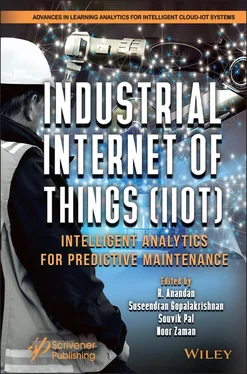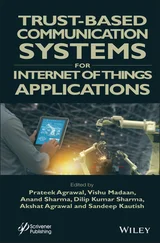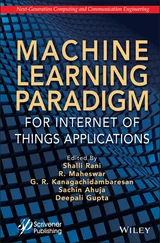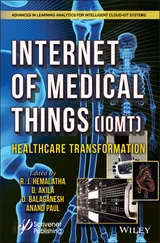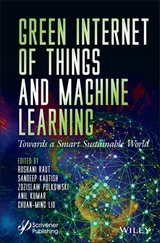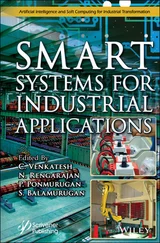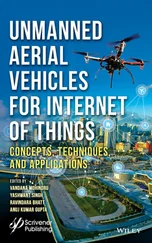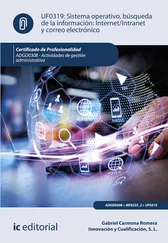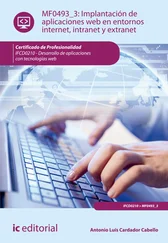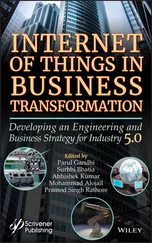Industrial Internet of Things (IIoT)
Здесь есть возможность читать онлайн «Industrial Internet of Things (IIoT)» — ознакомительный отрывок электронной книги совершенно бесплатно, а после прочтения отрывка купить полную версию. В некоторых случаях можно слушать аудио, скачать через торрент в формате fb2 и присутствует краткое содержание. Жанр: unrecognised, на английском языке. Описание произведения, (предисловие) а так же отзывы посетителей доступны на портале библиотеки ЛибКат.
- Название:Industrial Internet of Things (IIoT)
- Автор:
- Жанр:
- Год:неизвестен
- ISBN:нет данных
- Рейтинг книги:5 / 5. Голосов: 1
-
Избранное:Добавить в избранное
- Отзывы:
-
Ваша оценка:
- 100
- 1
- 2
- 3
- 4
- 5
Industrial Internet of Things (IIoT): краткое содержание, описание и аннотация
Предлагаем к чтению аннотацию, описание, краткое содержание или предисловие (зависит от того, что написал сам автор книги «Industrial Internet of Things (IIoT)»). Если вы не нашли необходимую информацию о книге — напишите в комментариях, мы постараемся отыскать её.
This book discusses how the industrial internet will be augmented through increased network agility, integrated artificial intelligence (AI) and the capacity to deploy, automate, orchestrate, and secure diverse user cases at hyperscale.
Audience
Industrial Internet of Things (IIoT) — читать онлайн ознакомительный отрывок
Ниже представлен текст книги, разбитый по страницам. Система сохранения места последней прочитанной страницы, позволяет с удобством читать онлайн бесплатно книгу «Industrial Internet of Things (IIoT)», без необходимости каждый раз заново искать на чём Вы остановились. Поставьте закладку, и сможете в любой момент перейти на страницу, на которой закончили чтение.
Интервал:
Закладка:
This book showcases industrial automation through the IoT by including case studies in the areas of the IIoT, robotic and intelligent systems, and web-based applications which will be of interest to working professionals and those in education and research involved in a broad cross section of technical disciplines. The diverse topics covered in the 15 chapters herein are briefly described below.
– Chapter 1provides an updated overview of the IoT and IIoT, addressing its evolution along with AI technology and its potential in the industry, approaching its relationship with a concise bibliographic background, and synthesizing the potential of the technologies.
– Chapter 2discusses the major challenges in securing IoT devices and the data being exchanged over the network. It also covers the manufacturers of IoT devices and the standards they follow. Security challenges such as privacy, confidentiality, integrity and reliability are also discussed in a broader manner.
– Chapter 3extensively covers the challenges concerning smart automation, and smart and grid management.
– Chapter 4focuses on how advanced forms of automated data processing connect with new types of computer vision (CV) applications that directly influence safety, thereby protecting human lives and physical assets in hazardous places.
– Chapter 5explains the use of precise system modeling along with appropriate objective function that can offer optimal solutions, along with the financial implications of using soft computing techniques.
– Chapter 6provides insightful knowledge on antenna designs, which can further help in future wearable antenna design research to fulfil the requirements of best wearable electronics.
– Chapter 7briefly reports on the numerous IoT devices used in daily life. Since the data generated by these devices are huge, there is a discussion on how it should be monitored, controlled, and acted upon using IoT data transmission protocols in data centers using various computing methods such as Fog, Cloud, Edge, and distributed computing along with machine learning techniques. Challenges faced in data centers and the IoT are also presented.
– Chapter 8provides insight into the challenges of drone delivery system and the use of IoT to overcome them.
– Chapter 9studies IoT-based water management system, including investigations of rate impediments in biophysical and geochemical measures to help biological system administrations concerning water quality.
– Chapters 10and 11further emphasize the numerous advantages of the industrial IoT.
– Chapter 12introduces a novel neural predictive classifier for improving the prediction rate of adverse drug reactions (ADRs), which is proposed to identify ADRs using the IoT.
– Chapter 13explains the impact that COVID-19 has had on the IIoT and gives an overview of IoT’s role in COVID-19, the benefits and challenges of the IIoT, and the effects of COVID-19 on industrial manufacturing and its impact on IoT-connected applications and digital transformation, and also the influence of COVID-19 on IoT application in general.
– Chapter 14paves the way for a comprehensive composite smart ambulance booking and tracking system using the IoT for digital services.
– Chapter 15discusses the increasing demand to solve health issues affecting the elderly, where the use of new IoT technology is completely changing their everyday lives, and promises to revolutionize modern healthcare by enabling a more personalized, preventive and collaborative form of care. Embedding devices with a cloud server and the sensor-cloud paradigm will give the elderly a more versatile facility. So, by analyzing security problems, such as authentication and data protection to protect the privacy of the elderly, an intelligent and safe health control system is proposed in this chapter with an IoT sensor focused on cloud storage and encryption.
In conclusion, we would like to extend our appreciation to our many colleagues and give our sincere thanks to all the experts for providing preparatory comments that will surely motivate the reader to read the topic. We also wish to thank the reviewers who took time to review this book. Also, we are very much grateful to our family members for their patience, encouragement, and understanding. Special thanks are given to the many individuals at Scrivener Publishing who contributed their talents and efforts in bringing this book to fruition. Finally, any suggestions to improve the text will be highly appreciated.
R. Anandan Suseendran Gopalakrishnan Souvik PalNoor ZamanJanuary 2022
1
A Look at IIoT: The Perspective of IoT Technology Applied in the Industrial Field
Ana Carolina Borges Monteiro1, Reinaldo Padilha França1*, Rangel Arthur2, Yuzo Iano1, Andrea Coimbra Segatti2, Giulliano Paes Carnielli2, Julio Cesar Pereira2, Henri Alves de Godoy2 and Elder Carlos Fernandes2
1 School of Electrical and Computer Engineering (FEEC), University of Campinas – UNICAMP, Av. Albert Einstein, Barão Geraldo, Campinas – SP, Brazil
2 Faculty of Technology (FT), University of Campinas – UNICAMP, Paschoal Marmo Street, Jardim Nova Italia, Limeira, Brazil
Abstract
The advent of solutions with AI (Artificial Intelligence) technology means tools and software that integrate resources that automate the process of making algorithmic decisions. Simply put, AI consists of systems or machines that mimic human intelligence to perform tasks improving iteratively over time based on the information collected. Thus, IoT currently matches a series of hardware that works connected to the internet, from a refrigerator to a wearable watch that measures heart rate and sends this data to an application. In this sense, it is possible to interpret what part of these devices uses, even on a small scale, AI technology. This technological innovation connects everyday intelligent devices or even intelligent sensors, to the internet, linking the physical world increasingly closer to the digital world. In this scenario, the world is experiencing a digital transformation, and related to it, the Industrial Internet of Things (IIoT) aims to connect different devices to collect and transmit data present in an industrial environment. Performing this communication through essential industrial variables related to smart devices, effecting communication, data, and data analysis. In this sense, this chapter is motivated to provide an updated overview of IoT and IIoT, addressing its evolution along with AI technology and potential in the industry, approaching its relationship, with a concise bibliographic background, synthesizing the potential of technologies.
Keywords: IoT, IIoT, industrial, IoT applications, sensors
1.1 Introduction
The concept behind the Internet of Things (IoT) is to connect several devices, through the internet which can exchange information with each other. Considering that this technology can be applied to industry, it makes this connection between these different devices generates Industry 4.0, which is reputable as the Fourth Industrial Revolution, being the new trend that is being adopted by large corporations to get ahead in the market, characterized by the introduction of information technology in the industry [1].
IoT in Industry 4.0 is basically responsible for the integration of all devices inside and outside the plant, considering that the concept represents the connection as it is a network of physical devices (objects), systems, platforms, and applications with embedded technology to communicate, feel or interact with indoor and outdoor environments [1, 2].
Industry 4.0 is the complete transformation of the entire scope of industrial production through the fusion of internet and digital technology with traditional industry, being motivated by three major changes in the productive industrial world related to the immense amount of digitized information, exponential advancement of computer capacity, and innovation strategies (people, research, and technology) [2, 3].
Читать дальшеИнтервал:
Закладка:
Похожие книги на «Industrial Internet of Things (IIoT)»
Представляем Вашему вниманию похожие книги на «Industrial Internet of Things (IIoT)» списком для выбора. Мы отобрали схожую по названию и смыслу литературу в надежде предоставить читателям больше вариантов отыскать новые, интересные, ещё непрочитанные произведения.
Обсуждение, отзывы о книге «Industrial Internet of Things (IIoT)» и просто собственные мнения читателей. Оставьте ваши комментарии, напишите, что Вы думаете о произведении, его смысле или главных героях. Укажите что конкретно понравилось, а что нет, и почему Вы так считаете.
